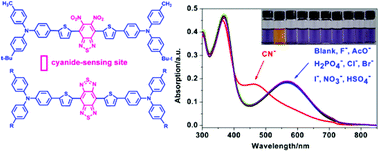Visible and near-infrared chemosensor for colorimetric and ratiometric detection of cyanide†
Abstract
A chemosensor system has been developed for rapid and selective detection of cyanide. The sensory molecules have the donor–acceptor type of structure and are designed by tuning the LUMO level or their reactivity towards cyanide. This sensory system is able to selectively distinguish cyanide among fluoride and many other anions at micromolar concentrations and instantly detect cyanide at ambient temperatures with a detection limit down to 1.0 µM. Multiple sensory signals are available and can be used for both qualitative monitoring and quantitative determination of cyanide, including high-contrast visual color change, fluorescence quenching and enhancement in the visible and near-infrared spectral regions.

- This article is part of the themed collection: Materials for Detection

 Please wait while we load your content...
Please wait while we load your content...